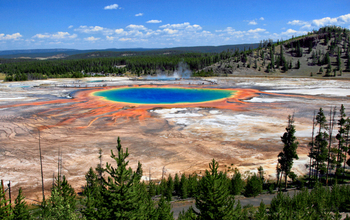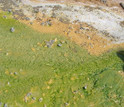Hola amigos: A VUELO DE UN QUINDE EL BLOG., Tierra podría contener cerca de 1 billón de especies, con sólo una milésima parte de un 1 por ciento ahora identificada, según los resultados de un nuevo estudio.
La estimación, basada en leyes de escala universales aplicadas a grandes conjuntos de datos, aparece hoy en las revista Proceedings de la Academia Nacional de Ciencias. Los autores del informe son Jay Lennon y Kenneth Locey de la Universidad de Indiana en Bloomington, Indiana.
Los científicos combinaron microbianas, vegetales y animales conjuntos de datos procedentes de fuentes científicas gubernamental, académico y ciudadano, lo que resulta en la mayor recopilación de este tipo.
En conjunto, estos datos representan más de 5,6 millones de especies microscópicas y no microscópicas de 35.000 localidades a través de todos los océanos y los continentes del mundo, excepto en la Antártida.
La estimación, basada en leyes de escala universales aplicadas a grandes conjuntos de datos, aparece hoy en las revista Proceedings de la Academia Nacional de Ciencias. Los autores del informe son Jay Lennon y Kenneth Locey de la Universidad de Indiana en Bloomington, Indiana.
Los científicos combinaron microbianas, vegetales y animales conjuntos de datos procedentes de fuentes científicas gubernamental, académico y ciudadano, lo que resulta en la mayor recopilación de este tipo.
En conjunto, estos datos representan más de 5,6 millones de especies microscópicas y no microscópicas de 35.000 localidades a través de todos los océanos y los continentes del mundo, excepto en la Antártida.
More information....
Largest analysis of microbial data reveals that 99.999 percent of all species remain undiscovered
 Credit and Larger Version |
Earth could contain nearly 1 trillion species, with only one-thousandth of 1 percent now identified, according to the results of a new study.
The estimate, based on universal scaling laws applied to large datasets, appears today in the journal Proceedings of the National Academy of Sciences. The report's authors are Jay Lennon and Kenneth Locey of Indiana University in Bloomington, Indiana.
The scientists combined microbial, plant and animal datasets from government, academic and citizen science sources, resulting in the largest compilation of its kind.
Altogether, these data represent more than 5.6 million microscopic and non-microscopic species from 35,000 locations across all the world's oceans and continents, except Antarctica.
Great challenge in biology
"Estimating the number of species on Earth is among the great challenges in biology," Lennon said. "Our study combines the largest available datasets with ecological models and new ecological rules for how biodiversity relates to abundance. This gave us a new and rigorous estimate for the number of microbial species on Earth."
He added that "until recently, we've lacked the tools to truly estimate the number of microbial species in the natural environment. The advent of new genetic sequencing technology provides a large pool of new information."
The work is funded by the National Science Foundation (NSF) Dimensions of Biodiversity program, an effort to transform our understanding of the scope of life on Earth by filling major gaps in knowledge of the planet's biodiversity.
"This research offers a view of the extensive diversity of microbes on Earth," said Simon Malcomber, director of the Dimensions of Biodiversity program. "It also highlights how much of that diversity still remains to be discovered and described."
Estimating numbers of microbial species
Microbial species are forms of life too small to be seen with the naked eye, including single-celled organisms such as bacteria and archaea, as well as certain fungi.
Many earlier attempts to estimate the number of species on Earth ignored microorganisms or were informed by older datasets based on biased techniques or questionable extrapolations, Lennon said.
"Older estimates were based on efforts that dramatically under-sampled the diversity of microorganisms," he added. "Before high-throughput genetic sequencing, scientists characterized diversity based on 100 individuals, when we know that a gram of soil contains up to a billion organisms, and the total number on Earth is more than 20 orders of magnitude greater."
The realization that microorganisms were significantly under-sampled caused an explosion in new microbial sampling efforts over the past several years.
Extensive sampling efforts
The study's inventory of data sources includes 20,376 sampling efforts on bacteria, archaea and microscopic fungi, as well as 14,862 sampling efforts on communities of trees, birds and mammals.
"A massive amount of data has been collected from these surveys," said Locey. "Yet few have tried to pull together all the data to test big questions."
He added that the scientists "suspected that aspects of biodiversity, like the number of species on Earth, would scale with the abundance of individual organisms. After analyzing a massive amount of data, we observed simple but powerful trends in how biodiversity changes across scales of abundance."
Scaling laws for all species
The researchers found that the abundance of the most dominant species scales with the total number of individuals across 30 orders of magnitude, "making it the most expansive scaling law in biology," says Lennon.
Scaling laws, like that discovered by the scientists, are known to accurately predict species numbers for plant and animal communities. For example, the number of species scales with the area of a landscape.
"Until now, we haven't known whether aspects of biodiversity scale with something as simple as the abundance of organisms," Locey said. "As it turns out, the relationships are not only simple but powerful, resulting in our estimate of upward of one trillion species."
The study's results also suggest that identifying every microbial species on Earth presents a huge challenge.
"Of those species cataloged, only about 10,000 have ever been grown in a lab, and fewer than 100,000 have classified genetic sequences," Lennon said. "Our results show that this leaves 100,000 times more microorganisms awaiting discovery -- and 100 million to be fully explored.
"Microbial biodiversity, it appears, is greater than we ever imagined."
-NSF-
Media Contacts Cheryl Dybas, NSF, (703) 292-7734,
cdybas@nsf.gov
Kevin Fryling, Indiana University, (812) 856-2988,
kfryling@iu.edu
Related WebsitesLife on Earth: National Science Foundation awards $23 million for studies of planet's biodiversity: https://www.nsf.gov/news/news_summ.jsp?cntn_id=136222
New insights into coral health hidden in reefs' microbiomes: http://www.nsf.gov/discoveries/disc_summ.jsp?cntn_id=138157
Earth Day is on the horizon. But is 'greener' always better?: http://nsf.gov/discoveries/disc_summ.jsp?cntn_id=134374&org=NSF
Staple of recipe favorites--the tomato--reveals processes that maintain biodiversity: http://nsf.gov/discoveries/disc_summ.jsp?cntn_id=129676
A Stream Is a Stream Is a Stream: Or Is It?: http://www.nsf.gov/discoveries/disc_summ.jsp?cntn_id=123855&org=NSF
The National Science Foundation (NSF) is an independent federal agency that supports fundamental research and education across all fields of science and engineering. In fiscal year (FY) 2016, its budget is $7.5 billion. NSF funds reach all 50 states through grants to nearly 2,000 colleges, universities and other institutions. Each year, NSF receives more than 48,000 competitive proposals for funding and makes about 12,000 new funding awards. NSF also awards about $626 million in professional and service contracts yearly.
Useful NSF Web Sites:
NSF Home Page:
http://www.nsf.gov
NSF News:
http://www.nsf.gov/news/
For the News Media:
http://www.nsf.gov/news/newsroom.jsp
Science and Engineering Statistics:
http://www.nsf.gov/statistics/
Awards Searches:
http://www.nsf.gov/awardsearch/

Heat-loving microbes form extensive mats at Octopus Geyser in Yellowstone.
Credit and Larger Version

The oceans' surface waters harbor vast numbers of life-sustaining microbes.
Credit and Larger Version
%20Lake_DAPI_r.jpg)
Bacteria, like these from a freshwater lake, are the most abundant organisms on the planet.
Credit and Larger Version
%20kbs_soil_75be4ef5-d42a-469b-bac5-9e0fba947660_r.jpg)
Soil is one of Earth's largest reservoirs of microbial diversity.
Credit and Larger Version
%20Fieldwork_r.jpg)
Data collected by field biologists were used to understand patterns of microbial biodiversity.
Credit and Larger Version
The National Science Foundation (NSF)
Guillermo Gonzalo Sánchez Achutegui
ayabaca@gmail.com
ayabaca@hotmail.com
ayabaca@yahoo.com
Inscríbete en el Foro del blog y participa : A Vuelo De Un Quinde - El Foro!

No hay comentarios:
Publicar un comentario